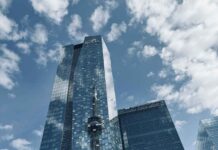As construction continues on The One, Toronto’s highly anticipated skyscraper, it begs the question: What does this architectural benchmark signify for the future of skyscrapers?
Standing tall in the heart of Toronto’s downtown, The One seeks to redefine the city’s skyline and make a lasting impact on urban architecture. Construction has sped up over the last year, with a new floor formed every week, Urban Toronto reported in May this year.
Finalized in June, The One, its development led by Sam Mizrahi, will reach a completed height of 328 meters and 91 storeys. With a blend of residential, commercial, and retail spaces, the completion of The One will not only mark a milestone for Toronto but also for the global skyscraper landscape.
This reflects changes to development — and to major cities in North America — that could become the new normal for downtowns across the continent.
Sustainable development
One aspect of The One is its commitment to sustainability. The tower incorporates advanced technologies and eco-friendly features, aligning with the growing trend of environmentally conscious construction. As skyscrapers continue to rise around the world, sustainability will play an increasingly pivotal role in their design and operation, ensuring a greener and more sustainable future for urban environments.
Moreover, The One’s architecture challenges conventional skyscraper norms. Its twisting and shifting design, courtesy of world-renowned architect Norman Foster, presents a new paradigm for high-rise structures. This departure from traditional straight lines and uniform shapes may inspire future architects to push boundaries and explore more daring designs in their skyscraper projects, according to a statement from Mizrahi Developments.
Rise of vertical mixed-use developments
The One’s completion also opens up opportunities for vertical mixed-use developments. By integrating residential, commercial, and retail spaces within a single structure, this skyscraper demonstrates the potential for creating vibrant, self-contained communities within the urban fabric.
This approach optimizes land use and enhances convenience for residents, fostering a live-work-play environment that’s increasingly common in a post-pandemic world.
Economic impact
Another significant implication of The One’s completion lies in its economic impact. The construction of such iconic structures stimulates the local economy, attracting investment and creating jobs. Skyscrapers like The One become landmarks that also draw tourists, driving further economic growth. The success of this project can serve as a catalyst for similar ambitious developments, sparking a ripple effect of urban renewal and transformation.
Vertical density
The One embodies the essence of vertical density. As urban populations continue to grow, high-density living becomes a necessity. Skyscrapers provide a solution by maximizing land use and accommodating a large number of residents and businesses in a compact space.
While other cities may have plenty of space to expand, density still offers advantages to city management that ultimately impacts residents as well.
“The completion of The One reinforces the notion that skyscrapers are integral to the future of urban living,” Sam Mizrahi said in a statement. “They allow cities to efficiently accommodate a growing population while preserving valuable land resources.”
Technology
In terms of technological advancements, The One showcases the integration of smart technologies for enhanced efficiency and connectivity. From intelligent energy management systems to advanced security features, smart skyscrapers like The One exemplify the potential of the Internet of Things (IoT) in transforming urban spaces.
This trend is likely to continue, with future skyscrapers embracing even more advanced technologies to create sustainable, intelligent, and user-centric environments.
As cities worldwide continue to grow and evolve, skyscrapers will play a vital role in shaping the urban landscape, and The One will likely inspire similar projects.
It serves as a testament to the possibilities of modern design in the context of changing needs of companies, workers and day-to-day lifestyle. As the project reaches its final stages, it’s an open question just how much other developers will follow suit.







